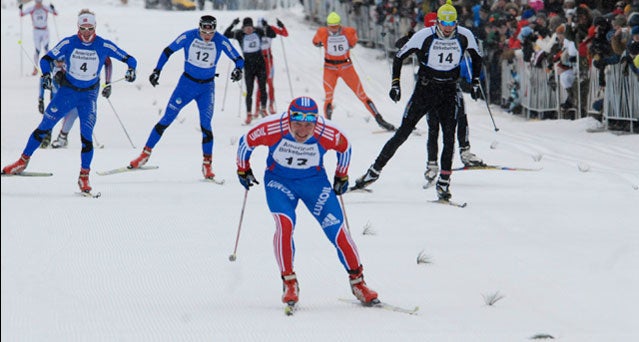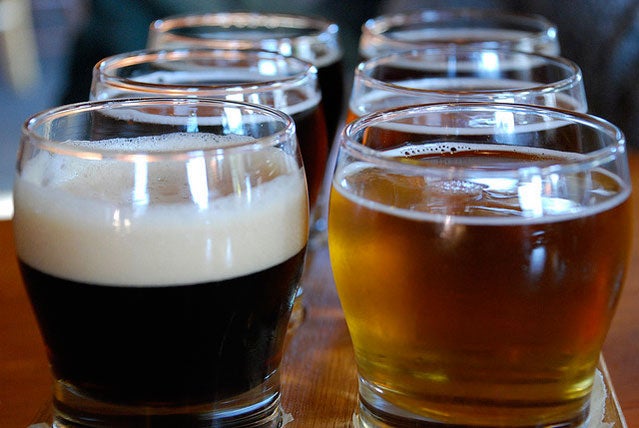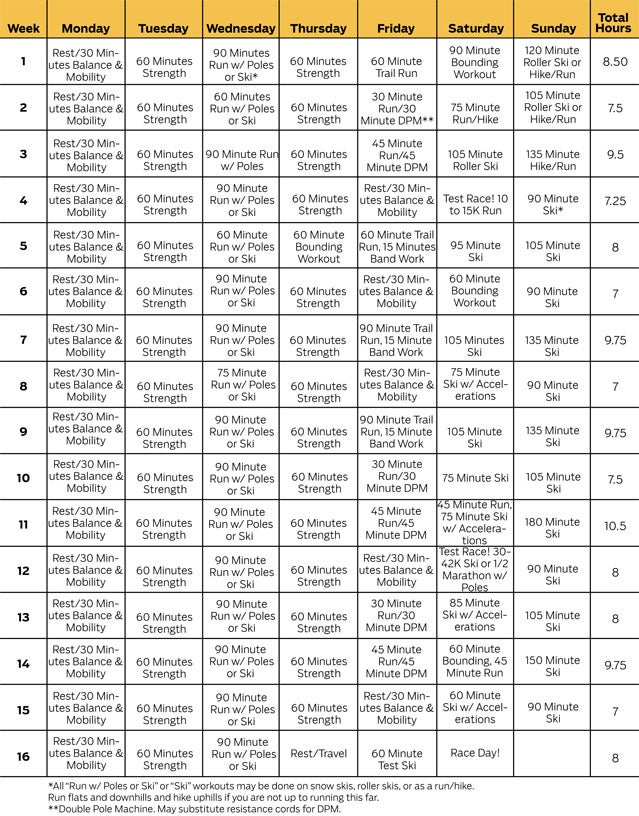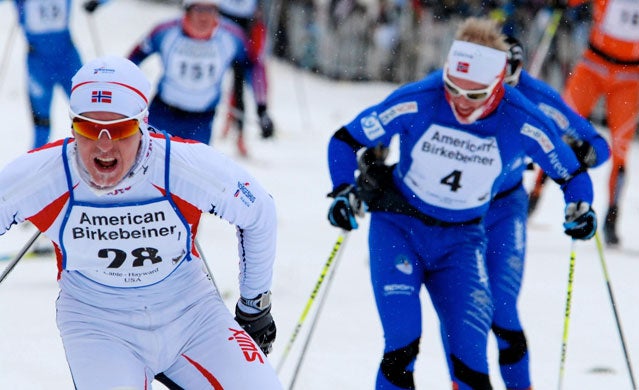At some point, perhaps while you’re waiting in the negative-ten degree weather at the starting line of the , you’ll question your sanity. Depending on which course you chose, the classic or skate race, you have 33.5 or 31 miles, respectively, between you and the brats and Floppin’ Crappie Ale in the 50-degree tent at the finish.
When the race begins, you and 9,399 other skiers will take to 20-foot-wide groomed trails that wind through the birch, maple, and pine trees around the towns of Cable and Hayward. Except for the mangled mess of skis cracking against shins at the start, you’ll enjoy the camaraderie and the grace of planks sliding through snow.
Then you’ll hit Bitch Hill, a 14 percent, 660-foot-long incline six miles from the finish. That’s not the worst of it. If there’s a heavy headwind blowing across Lake Hayward, be prepared to hunker down and form a paceline with fellow competitors. On the other side, you’ll hear crowds cheering and bells ringing as you take your final strides down Main Street’s finish chute.
“During the race, you’ll think, Why am I doing this?” says Ned Zuelsdorff, the ’s executive director. “Then a couple weeks after crossing that finish line, you’ll be signing up again.”
quickly; last year’s race sold out in mid-December. Start our 16-week training plan—by renowned Birkie coach Bill Pierce—and read on so you won’t be questioning your wax, layer choice, and stamina at the starting line.
Take Your Training to the Next Level — Sign up for the from the ���ϳԹ��� Fitness Center to get email reminders, watch instructional videos, and track your progress online.
The Birkie Dozen
Cross-country skiers share the 12 secrets of a successful Birkebeiner race

Cross-country skiing distances of more than ten miles demands two things: endurance and skill, the primary element of which is balance. Successfully skiing the Birkie on your first try takes one more thing: insider knowledge. Lucky for you, we’ve assembled advice from a crew of veterans to get you to the finish line as quickly and as comfortably as possible.
1. Sweat the Technique
Since 2008, the Birkebeiner has been divided into two races according to different cross-country skiing techniques, the classic and the skate. Each race starts off on a separate course, then they come together about halfway through. Classic skiing uses a walk/run motion while skating uses one similar to rollerblading or rollerskating.
The best way to test the techniques is to take at least one trip to the snow before the race. Two or three days will allow you to break in your equipment and get comfortable moving on skis. If that’s not possible, and you’ve never cross-country skied before, Pierce recommends the classic technique, which has the motto, “If you can walk, you can ski.” Ned Zuelsdorff agrees. “If you bonk, it might be a little bit easier to move forward if you’re classic-skiing.”
Pierce’s plan incorporates activities that closely mimic snow technique, including roller skiing, ski walking and bounding, double-poling machines, and running. He also recommends checking in with a coach who can instruct you on basic technique and movement patterns. To learn more about the classic technique, . Curious about skate skiing? to learn more.
2. Choose Wisely
“Make sure you get a pair of skis that fit you,” says Caitlin Gregg, 2011 female skate champion and course record holder. Cross-country skis come in different lengths and flexibilities, so your height and weight will factor into your selection. Hit up a local ski shop or check out . Recreational ski packages at Hayward’s , which include wood-core classic skis, poles, and boots, start at $278, while a pair of carbon skate skis could run you up to $600. Don’t want to buy? Reserve rental equipment in advance at , located about eight miles from the race start.
3. Practice, Practice, Practice
“Most of the racers are mountain bikers, road cyclists, kayakers—they compete in other sports and don’t ski train,” says Pierce. “But if you haven’t ever skied before, chances are you won’t make the cutoffs.” If you live in Florida and this will be your first race, don’t worry. Our 16-week training plan will give you the ski-specific strength and endurance necessary to finish. Just don’t expect to take off like a pro your first time around.����
Practice by following the technique-specific workouts in the training plan, including running with poles. Arrive two days before the event to try out your equipment and technique. (Note: If your Birkie training doesn’t go as planned, you can enter the 23K Kortelopet or the 12K Prince Haakon races instead. There’s also a kids’ race, the Barnebirkie, so you can bring the family.)
4. Save the Date
If you’re not within driving distance, fly into Minneapolis-St. Paul, located about three hours from the race start in Cable, then rent a car. Use . Make sure to book your lodging as early as possible, as this event sells out hotels within a 50-mile radius of Cable and Hayward. , located at the race start, is a good option.
5. Wax On
“If you’re racing the classic, and your skis start slipping because you don’t have good kick wax, that is the worst,” says Jennie Bender, 2011 female classic champion and course record holder. We know. You’re wondering what the heck kick wax is. Start studying wax by going online to or by attending a wax seminar at ski shop on your way out of Minneapolis. Listen to what the race organizers recommend at bib pick-up for any last minute wax tweaks.
6. Arrive Early
“There are long lines for the bathrooms on each floor of Telemark Lodge,” Bender said. “People are just frantic.” Plan to get to the race site an hour before the start to take care of bathroom business, orient yourself, and stay warm in the lodge.
7. Think Before You Start
“Racers often worry that they’ve forgotten something or stress over their wax,” said Zuelsdorff. Don’t worry if you accidentally miss your wave because you were putting your extra warm clothes in a drop bag or waiting in the bathroom line. Your time won’t begin until you cross the start line, Zuelsdorff says.
8. Layer, Layer, Layer
Start with long underwear, and steer clear of cotton. “Definitely put money into something that won’t get wet right off the bat,” says Bender. Wool or polyester works well. On top of that, wear ski tights or pants and a jersey. Zuelsdorff says most racers wear either a cycling or ski jersey. Top if off with a hat or Buff headwear, glasses or ski goggles, and gloves. If it’s really cold, as it has been the past few years, toss hand warmers in your gloves and toe warmers in your boots, and consider a jacket or windbreaker. Remember: you can always take something off, but you can’t put something on that you didn’t have to start with.
9. Pace Yourself
Coach Pierce advises you to start easy for the first 15K, then keep it steady for the next 15K. “The last 11 to 15K is where the race starts and where your real work begins,” Pierce says. “You will want to have a fair amount of reserves left for the last 11K.” In that last 11K, there are five climbs, the second of which is the legendary Bitch Hill. At about 200 meters long, it’s the shortest of the five, but its 14 percent incline makes it the steepest.
10. Be Patient and Stay Positive
“Skiing is a lot like golf,” Pierce says. “A lot of people just go out and do it, but it’s a highly complex sport that requires the skill of full-body coordination.” Just like you probably won’t hit a hole in one without spending time at the driving range, don’t expect to crush this course your first time around on endurance training alone.
“A high percentage of this race is mental,” says Juergen Uhl, 2011 male classic champion. “Everybody, especially the first time, has a part where it’s like, ‘Ugh! I’m never gonna be able to do it.’” Take solace in knowing that more than 9,000 other people are suffering with you, and think about a dry phrase to crack at the end as you sip that first beer with your peers.
11. Make Friends
“Skiing is kind of like riding your bike—there’s a lot to be said for drafting,” Pierce says. Make friends so that when you get to Hayward Lake, you can take turns pulling each other into the wind. Rotate a new leader every 30 seconds and you’ll get across the lake to the finish chute faster than if you go it alone. Just don’t be a drag. Drafting without taking a pull or silently tucking in behind another skier is bad form.
12. Enjoy the Race
“It’s so refreshing to go into a race that you’ve never done before,” says Bender, who won the classic race and set a new course record—on her first try. There are no expectations, so you can just enjoy it. Next time, you can start boasting about wave placement like the Birkie vets. The lower your wave number, the higher your pre-race bragging rights.
The Birkebeiner Nutrition Guide
Pick the right fuels so you don’t skid to a halt during America’s biggest cross-country ski race

Cross-country skiing and running burn a similar amount of calories—500 to 1,000 per hour, depending on intensity. The average person finishes the Birkie, classic or skate, in about four hours—unless the Hayward ski patrol hauls them off the course early. Adam Korzun, high-performance dietician for the U.S. Ski and Snowboard Association, outlines a race-week nutrition strategy that will keep you strong through the finish line.
WEEK BEFORE
“It’s an old-school approach to eat a huge meal the night before, but it takes 24 to 48 hours to process all of that glycogen,” Korzun says. Instead, focus on getting enough carbs during the week leading up to the event. “You’ll be tapering, so you’re not going to be doing the same volume of training.” Continue to eat as if you were still training hard and your glycogen stores will be toped off for race day, without the bloat or water retention that can accompany car loading. While training, focus on fruits, vegetables, nuts, whole grains, fish, and lean meats.
As for that last supper, eat something you’re comfortable with and know you tolerate well. For some people, that might be pasta with meat sauce, a salad, and bread. For others, a chicken-and-rice burrito or chicken stir-fry will do the trick. “At that point, at least half of the meal should be carbohydrates,” Korzun said. And if you want dessert, go for it, as long as its something you know your stomach can handle.
RACE MORNING
Again, stick with the familiar. “Eat whatever you do on training days on race day,” Korzun says. “It’s one less thing to worry about.” If you’re a bacon-and-eggs person, practice eating a breakfast with carbs during your training days, Korzun said. Korzun’s skiers like to eat oatmeal or granola with fruit and Greek yogurt. Eat a carb-rich breakfast on race day one to two hours before you start. If you have a nervous stomach, eat three hours before starting—just be sure to have a small snack like a gel or half a sports bar 15 to 30 minutes before the gun.
DURING THE RACE
“Don’t let yourself run out of fuel, then play catch-up,” Korzun says. Plan your nutrition ahead so you’re eating or drinking something every 20 to 30 minutes. Korzun recommends between 30 and 60 grams of carbohydrates per hour—that’s 120 to 240 calories—depending on how hard you are skiing. The harder you ski, the more carbs you need to keep you going. Try drinking a sports drink like Gatorade and eating gels, blocks, or Korzun’s favorite, Clif Kid Twisted Fruit. “They’re delicious and they don’t freeze into a block or get super sticky, either,” he says.
Elite skiers staple gel packets to their jerseys so they can rip one off and slam it without breaking stride. If you don’t mind a short break, stop at one of nine aid stations, located about every 5K. They’re stocked with water, sports drinks, gels, fruit, and any other goodies. Don’t want to stop? Consider wearing a fuel belt. Just be warned that the liquids racers carry have been known to freeze at this event.
POST-RACE
As soon as possible after crossing the finish line, eat. You need carbs to replenish your glycogen stores, protein to aid muscle recovery, and fluid to avoid dehydration. Eat a sports bar, if that’s most convenient. A piece of fruit and string cheese, a turkey sandwich, or peanut butter on an English muffin will work. Most likely, you’ll head straight for the Birkie celebration tent, where a Wisconsin victory buffet of pilsner, ale, and porter will be available from Eau Claire’s . “The maltose in beer is actually the most quickly absorbed sugar on the planet,” Korzun says. “There’s also water in beer and B vitamins.” So drink the beer. Just realize that man cannot properly recover on beer alone. To that end, the tent also houses soup, burgers, and, of course, brats.
Birkebeiner Training Plan
Coach Bill Pierce’s 16-week plan to prepare you for America’s biggest cross-country ski race

Follow the strength and endurance workouts in the 16-week plan above to finish the American Birkebeiner strong, with time to spare.
For a more detailed interactive plan including videos, e-mail reminders, and the ability to track your progress, sign up for our from coach Bill Pierce.


